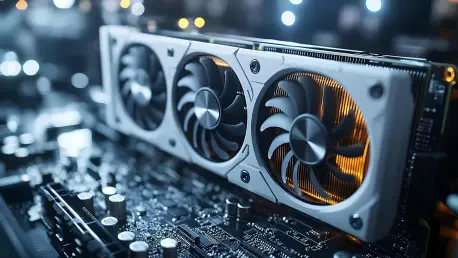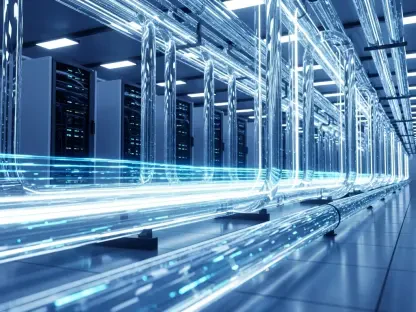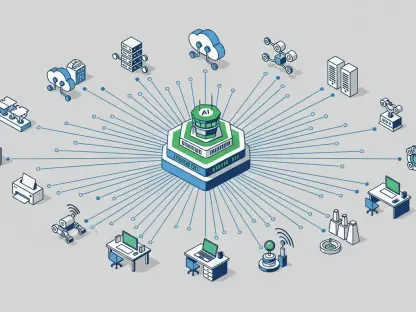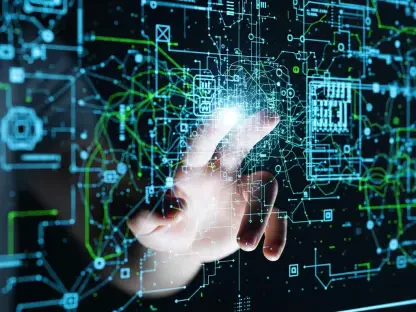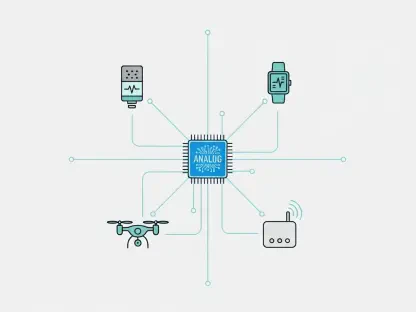Artificial Intelligence (AI) continues to revolutionize industries, imposing significant changes in technology and hardware needs; as AI models become more sophisticated, the demand for specialized processing units increases, prompting a shift from traditional CPUs to GPUs and NPUs. This article explores the evolution of AI hardware, the reasons behind this transition, and the trade-offs involved, reflecting on how major players in the tech industry adopt different strategies to address these needs.
The Necessity for Specialized Hardware
The complex computational demands of AI necessitate tailored hardware solutions. Traditional CPUs, designed for general-purpose computing tasks, struggle to handle the intense calculations involved in deep learning and large dataset processing. Given the need for high efficiency and speed, the industry has steadily moved towards developing and adopting specialized chips. The rise of graphics processing units (GPUs) and neural processing units (NPUs) highlights this trend, with their architectures optimized for the unique demands of AI workloads.
GPUs, renowned for their parallel processing capabilities, became instrumental in handling AI workloads beyond their original purpose of enhancing gaming graphics. They handle multiple simultaneous tasks, making them exceptionally suitable for the training phase of AI model development. This phase demands immense computational power, a need that GPUs address with their numerous cores capable of performing many operations in parallel. However, traditional CPUs fall short in this role due to their sequential processing nature, which leads to inefficiencies when dealing with AI’s intensive computations.
In contrast to GPUs, NPUs were explicitly designed for AI tasks, particularly the inference phase. Inference involves using a trained model to make predictions or decisions, necessitating rapid, real-time responsiveness and lower power consumption. NPUs offer a targeted solution for these requirements, adding another layer of specialization to the AI hardware landscape. This targeted approach helps optimize computing processes and addresses specific performance and efficiency needs beyond the capabilities of general-purpose CPUs.
Evolution and Advantages of GPUs
GPUs were not originally designed with AI in mind but have become essential tools in the industry due to their unparalleled parallel processing power. Initially developed to upgrade the visual experience of video games, GPUs were repurposed as AI research demanded more from computing hardware. The pivot came with NVIDIA’s introduction of the CUDA platform in 2006, a game-changer that repurposed GPUs for general computing needs, particularly parallel processing. This transformation positioned GPUs as the backbone of deep learning, making them a staple in AI research and development.
The evolution of GPUs as the go-to hardware for AI is largely attributed to their ability to handle numerous computations simultaneously. With many cores designed to process multiple tasks at once, GPUs excel in the training phase of deep learning models. Training models require vast amounts of data and complex algorithms, and GPUs’ architecture is perfectly suited to manage these tasks efficiently. This shift was marked by the realization that general-purpose CPUs were woefully inadequate for the burgeoning needs of AI.
The adoption of GPUs in AI has accelerated advancements in the field, enabling the development of increasingly sophisticated models. Their ability to perform a vast number of computations concurrently means tasks that were previously impossible or would take an infeasible amount of time with CPUs became achievable. This rapid progress in AI capabilities is a direct result of leveraging the strengths of GPU hardware, driving forward innovations in machine learning, neural networks, and other AI technologies.
Inference vs. Training: Differentiating Workloads
A pivotal distinction in AI processing involves the different demands of training models and performing inference. These two phases of AI require different hardware specifications to optimize performance and efficiency. While GPUs have dominated the training stage due to their unrivaled computational power, they might be overkill for inference tasks. Inference demands real-time responsiveness and lower power consumption, highlighting the need for NPUs.
Training a model involves iterating over large datasets to fine-tune the parameters of AI algorithms. This step is resource-intensive, running operations on massive scales, making GPUs the ideal choice with their ability to handle extensive parallel computations. However, once the model is trained, the focus shifts to inference, where the trained model is employed to make predictions based on new data inputs. This process requires a different set of optimizations, as it benefits from quick, efficient computation rather than raw processing power.
NPUs come into play in inference, tailoring their architecture to handle the specific mathematical operations required by AI with greater efficiency and lower power usage. Unlike GPUs, which are designed for broad applicability, NPUs focus on performing specific tasks well—particularly those involving the application of a trained AI model. This makes them more suitable for devices and applications where energy consumption and heat generation must be minimized, and where real-time processing is critical, such as in smartphones, autonomous vehicles, and edge devices.
Rise of NPUs in Real-World Applications
Neural Processing Units (NPUs) have risen to prominence in real-world applications, mainly due to their efficiency in handling AI inference tasks. As companies strive for better performance while managing power consumption, NPUs have become critical in integrating AI capabilities within consumer and industrial products. Tech giants such as Apple, Google, and Tesla exemplify this trend by incorporating NPUs to optimize on-device AI processes and enhance functionality without excessively consuming power.
Apple’s implementation of NPUs in its devices exemplifies the benefits of integrating specialized hardware for AI. The Neural Engine, a key component in the recent generations of iPhones and iPads, significantly enhances on-device AI functionalities. From facial recognition to augmented reality applications, the Neural Engine enables swift, power-efficient AI processing, ensuring a seamless user experience without the need for cloud-based processing. This on-device approach mitigates latency issues and enhances privacy protections by keeping sensitive data processing local.
Google has leveraged its Tensor Processing Units (TPUs) in its cloud services, focusing on sustainable and scalable solutions for handling AI workloads. TPUs are powerful NPUs designed to accelerate machine learning tasks, offering performance and efficiency benefits over GPUs for specific applications. By using TPUs, Google aims to optimize its data centers’ energy consumption while delivering robust AI capabilities to its cloud customers, emphasizing the importance of efficient and scalable AI infrastructure.
Tesla’s proprietary chip development for real-time AI inference showcases NPUs’ critical role in autonomous vehicle capabilities. The specialized hardware supports the extensive computations required for navigation, object detection, and decision-making in real time, ensuring safe, efficient autonomous driving experiences. The NPUs’ ability to process vast amounts of data from sensors quickly and efficiently is central to the operation of Tesla’s Full Self-Driving system.
Financial and Operational Trade-offs
Selecting the right AI hardware involves significant financial and operational considerations. While GPUs provide immense computational power and versatility, they come with high upfront costs and substantial energy demands. These factors make investment in GPUs a serious commitment, particularly for organizations focused on large-scale, complex AI training tasks. On the other hand, NPUs present a more cost-effective approach, though with limitations in flexibility, making them ideal for specific, repetitive inference tasks.
GPUs require considerable physical infrastructure to support their power and cooling needs, contributing to higher operational costs. For organizations running extensive AI training operations, the substantial energy usage of GPUs translates to significant expense, not only in terms of direct energy costs but also regarding the cooling systems required to manage the heat generated. This financial burden is a crucial factor in strategic decision-making concerning AI hardware investment.
NPUs, despite their lower flexibility compared to GPUs, offer cost and energy efficiency ideal for tasks where specific, repetitive computations dominate. NPUs are typically specialized for inference, operating with less power and requiring simpler cooling solutions. This characteristic makes them suitable for applications where energy consumption and operational efficiency are priorities. The cost savings in energy and infrastructure can outweigh the initial limitations in their use, balancing the financial scales in their favor for particular use cases.
Evaluating these trade-offs involves also considering the long-term implications for scalability and sustainability. GPUs, with their versatility and high performance, play a critical role in advancing AI capabilities through the significant computational power they provide. However, NPUs stand out for their operational efficiency, leading to more sustainable AI processes, especially as organizations seek to minimize their carbon footprint and control energy-related expenses.
Developer Experience and Ecosystem Maturity
The developer ecosystem encompassing AI hardware considerably impacts its adoption and usability. GPUs benefit from mature software platforms like NVIDIA’s CUDA, providing extensive libraries and tools that streamline development and optimize performance. This well-established ecosystem enhances the developer experience, allowing for rapid prototyping, efficient debugging, and comprehensive performance monitoring. The availability of resources and community support further contributes to GPUs’ widespread adoption in AI research and development.
The CUDA platform stands out as a crucial facilitator in the AI development landscape, enabling developers to leverage GPUs’ full potential. Comprehensive support for parallelized operations and extensive libraries for various AI applications make CUDA indispensable for efficient and effective GPU utilization. This established foundation simplifies the training, deploying, and scaling of AI models, reducing the barriers to entry for leveraging advanced AI techniques and driving innovation forward.
Conversely, NPUs often face challenges related to the lack of equally mature ecosystems, which can slow down the development process and pose additional hurdles for developers. The nascent stage of NPU software support means developers may encounter a steeper learning curve, fewer pre-existing tools, and potentially less community assistance. This situation can lead to inefficiencies and slower adoption rates despite the potential operational advantages NPUs present.
Efforts to enhance the NPU ecosystem are ongoing, with companies investing in developing robust frameworks and tools to reduce the development gap. As NPU platforms grow more sophisticated, the adoption rate will likely increase, making it easier for developers to optimize AI inference tasks using NPUs. Bridging these gaps is vital for realizing the full potential of specialized hardware in the AI landscape.
Strategic Hardware Decisions by Major Tech Companies
Major tech companies have made distinct strategic choices regarding their AI hardware, each reflecting their specific business needs, technical requirements, and long-term goals. By examining the different approaches, one can appreciate the diversity in AI hardware strategies and their implications for the industry.
Google has taken significant steps with its use of TPUs to enhance efficiency within its cloud services. TPUs, optimized for both training and inference tasks, offer a balanced solution aiming at performance and energy sustainability. This decision aligns with Google’s focus on providing scalable and environmentally responsible AI capabilities to its cloud customers. The ability to deliver powerful AI services while managing operational efficiency and energy consumption reflects Google’s strategic emphasis on sustainability.
Apple, on the other hand, has integrated NPUs into its devices to bolster on-device AI capabilities. By including the Neural Engine in iPhones and iPads, Apple enhances user experience through features like advanced image processing, quick facial recognition, and efficient natural language processing. This strategy prioritizes seamless, power-efficient AI operations directly on consumer devices, reducing reliance on cloud-based services and thus improving privacy and reducing latency.
Tesla’s approach to AI hardware revolves around developing proprietary chips designed explicitly for the demanding real-time processing needs of autonomous vehicles. These custom-built NPUs enable rapid, efficient processing of data from various sensors, crucial for safe and effective autonomous driving. Tesla’s focus on achieving low-latency inference at the highest possible efficiency highlights the need for tailor-made solutions in implementing critical, real-time AI functions.
AWS (Amazon Web Services) offers a dual solution with Trainium for training and Inferentia for inference, providing its cloud customers with cost-effective alternatives to traditional GPUs. This dual-hardware approach allows AWS to cater to different AI processing needs efficiently, offering optimized performance and cost savings. By providing specialized hardware for both training and inference, AWS ensures it can meet the diverse demands of its extensive customer base, fostering a more versatile and powerful cloud AI environment.
Emerging Trends and Innovations
The dynamic nature of AI hardware development is particularly evident in the rise of innovative solutions from startups. Many of these smaller firms are pioneering budget-friendly technologies such as RISC-V-based NPUs, which highlight the competitive and fast-paced evolution of AI-capable hardware. This innovation drives the industry forward by providing diverse, scalable, and cost-effective hardware solutions tailored for AI.
These emerging technologies reflect the industry’s ongoing segmentation of AI workloads. The practice of utilizing GPUs primarily for training and NPUs for inference allows organizations to maximize performance and efficiency. This division of labor also helps manage costs more effectively, ensuring that resources are allocated where they are most needed without unnecessary expenditure. Startups play a critical role by introducing new ideas and solutions that challenge established paradigms and push the boundaries of what AI hardware can achieve.
Furthermore, as AI models and new architectures evolve, they push the industry to continuously adapt and innovate. The future direction of AI hardware will likely involve further specialization and increased efficiency, driven by the needs of increasingly sophisticated and complex AI applications. Current trends indicate a rising demand for chips designed for specific tasks, optimizing both the training and inference phases of AI deployment, reflecting a move toward more robust, tailored solutions.
Future Directions in AI Hardware
Artificial Intelligence (AI) continues to make profound changes across various industries, especially concerning technology and hardware requirements. As AI models become increasingly complex and sophisticated, there’s an escalating demand for specialized processing units. This has led to a significant transition from traditional Central Processing Units (CPUs) to Graphics Processing Units (GPUs) and Neural Processing Units (NPUs).
Central to this shift is the inherent capability of GPUs to handle the parallel processing required for AI tasks far more efficiently than CPUs. Similarly, NPUs, designed explicitly for AI workloads, offer substantial advantages in performance and power efficiency. This article delves into the historical evolution of AI hardware and the driving factors behind this shift. It also examines the trade-offs, such as increased energy consumption and higher costs associated with advanced hardware.
Reflecting on how major technology companies adapt, different strategies emerge. While some firms invest heavily in developing proprietary hardware tailored to their specific needs, others opt for versatile, commercially available solutions. The landscape of AI hardware is continuously evolving, with each approach presenting its own set of benefits and challenges. Understanding these dynamics is crucial for navigating the future of technology in an AI-driven world.
